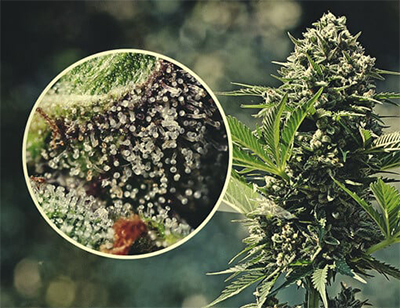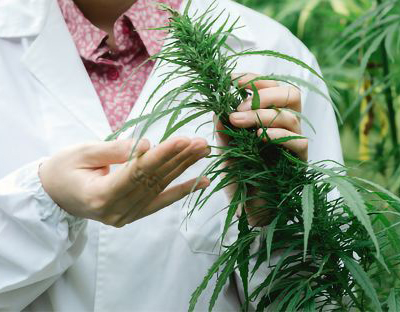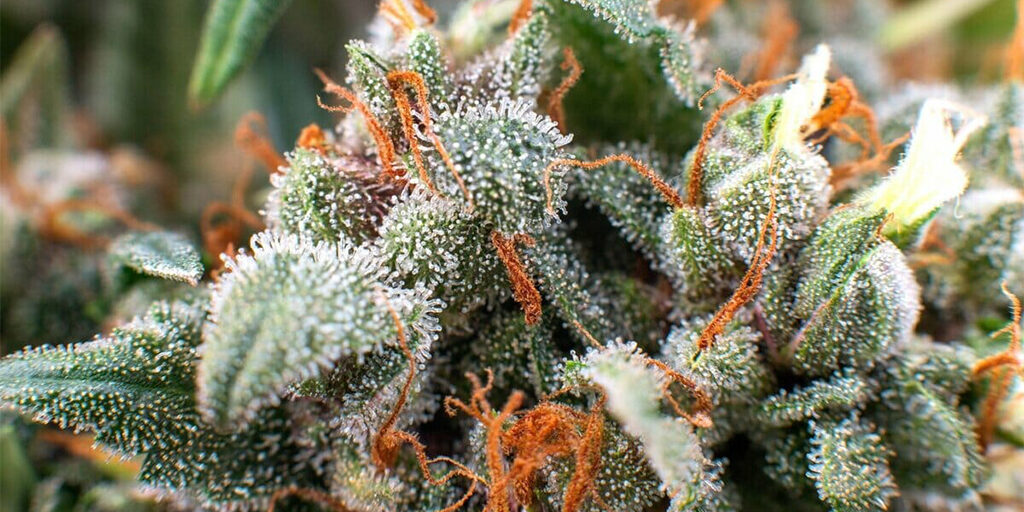In the world of cannabis cultivation and consumption, there exists a microscopic wonder that holds immense significance: cannabis trichomes. These tiny structures, barely visible to the naked eye, play a crucial role in the plant’s biology, potency, and therapeutic properties. In this article, we will look into the intricate world of cannabis trichomes, exploring their anatomy, functions, and the impact they have on the overall cannabis experience.
Anatomy of Trichomes
Trichomes are hair-like outgrowths that emerge from the surface of the cannabis plant’s leaves, stems, and flowers. They resemble fine, crystalline structures, giving the plant a frosty or shimmering appearance. While trichomes can vary in size and shape, they typically consist of a stalk and a head, with the head containing the majority of the plant’s bioactive compounds.
Types of Trichomes
 Cannabis plants produce several types of trichomes, each with its unique characteristics and functions. The three primary types are:
Cannabis plants produce several types of trichomes, each with its unique characteristics and functions. The three primary types are:
Bulbous Trichomes
These are the smallest of the trichomes, barely visible to the naked eye. They appear as tiny spherical structures and contain fewer cannabinoids and terpenes compared to other types.
Capitate Sessile Trichomes
Slightly larger than bulbous trichomes, capitate sessile trichomes possess a short stalk and a glandular head. These trichomes are abundant on the surface of leaves and stems, contributing to the plant’s overall cannabinoid content.
Capitate-Stalked Trichomes
Among the largest and most abundant trichomes, capitate-stalked trichomes feature a long stalk and a prominent glandular head. These trichomes are primarily found on the surface of cannabis flowers, where they produce and store the highest concentrations of cannabinoids and terpenes.
Functions of Trichomes
 Trichomes serve multiple essential functions in the life cycle of the cannabis plant, as well as in its interactions with the environment and other organisms:
Trichomes serve multiple essential functions in the life cycle of the cannabis plant, as well as in its interactions with the environment and other organisms:
Protection
One of the primary functions of trichomes is to defend the cannabis plant against environmental stressors and potential threats such as pests, UV radiation, and excessive transpiration. The sticky secretions produced by glandular trichomes can deter herbivores and inhibit the growth of harmful microorganisms.
Regulation of Transpiration
Trichomes help regulate the plant’s rate of transpiration by reducing water loss through the leaf surface. This adaptation is particularly beneficial in arid climates or during periods of drought, where conserving water is essential for the plant’s survival.
Production of Bioactive Compounds
The glandular heads of trichomes are responsible for synthesizing and storing the cannabinoids, terpenes, and other phytochemicals that define the therapeutic and psychoactive properties of cannabis. These compounds, including THC, CBD, and various terpenoids, are produced in response to environmental cues and play a vital role in the plant’s defense mechanisms.
Impact on Cannabis Quality and Potency
The presence and abundance of trichomes significantly influence the overall quality and potency of cannabis products. Higher concentrations of trichomes, especially glandular trichomes, are associated with increased levels of cannabinoids and terpenes, resulting in more potent and flavorful flowers or extracts.
Furthermore, the maturity and development of trichomes are crucial indicators of the plant’s readiness for harvest. As cannabis flowers reach their peak potency, trichomes transition from clear and translucent to cloudy or amber-colored, signaling the optimal time for harvest to maximize cannabinoid content and therapeutic effects.
Applications in Cannabis Cultivation and Processing
 Cultivators and cannabis enthusiasts employ various techniques to enhance trichome production and preserve their integrity throughout the cultivation and processing stages. These methods include:
Cultivators and cannabis enthusiasts employ various techniques to enhance trichome production and preserve their integrity throughout the cultivation and processing stages. These methods include:
Selective Breeding
Breeders selectively cross cannabis strains to enhance desirable traits, including trichome density, cannabinoid profiles, and terpene expression. By breeding plants with high trichome production, cannabis cultivators can develop strains with superior potency and aroma profiles.
Environmental Manipulation
Environmental factors such as light intensity, temperature, humidity, and nutrient availability can influence trichome development and resin production in cannabis plants. Cultivators adjust these parameters to optimize trichome production and ensure the highest possible quality in their final products.
Extraction Techniques
During the extraction process, manufacturers utilize specialized methods such as solvent extraction, mechanical separation, or CO2 extraction to isolate and concentrate the bioactive compounds contained within trichomes. These extracts are then used to create a wide range of cannabis products, including oils, concentrates, edibles, and topicals.
Conclusion
Cannabis trichomes represent nature’s intricate adaptation to environmental challenges, as well as a treasure trove of therapeutic compounds with vast potential for medicinal and recreational applications. Understanding the anatomy, functions, and significance of trichomes is essential for cultivators, researchers, and consumers alike, as it enables us to unlock the full spectrum of benefits offered by this remarkable plant. As research continues to unravel the mysteries of cannabis trichomes, we can expect further innovations and advancements in cultivation techniques, product development, and therapeutic applications, ultimately enhancing our appreciation and utilization of this botanical marvel.

